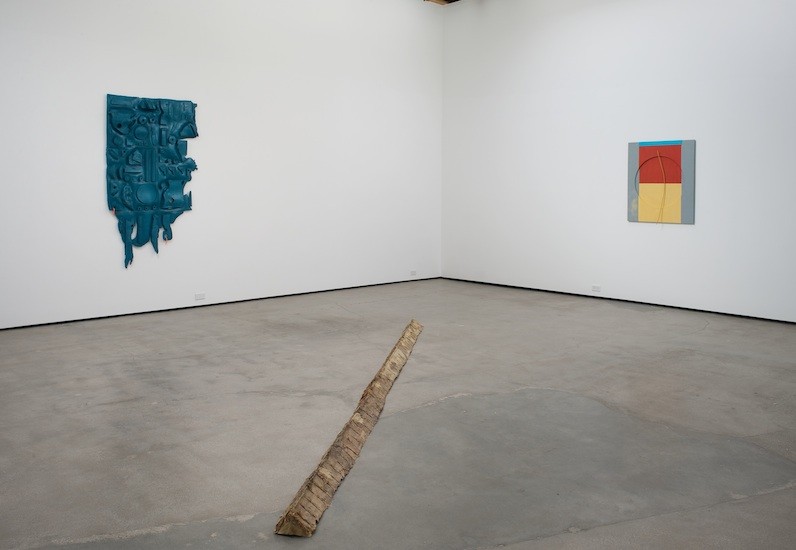A Group Exhibition Featuring The Work Of Robert Overby
10 Nov 2012 - 05 Jan 2013
ROBERT OVERBY / ERIK FRYDENBORG / JOHN HENDERSON / NOAM RAPPAPORT
10November 2012 - 5 January 2013
Cherry and Martin is pleased to announce a group exhibition placing the work of Robert Overby (1935-1993) in a context with works by Erik Frydenborg, John Henderson and Noam Rappaport.
The exhibition opens November 10 and continues through January 5, 2013. The gallery will be closed for the Thanksgiving holiday November 22-24, 2012.
Over the course of an almost thirty year career, Robert Overby (1935-1993) investigated the relationship between image and object, demonstrating a thoughtful, often punning, approach, realized in a range of materials and mediums. In 1971, Robert Overby discovered latex rubber as a casting medium; prior to that, he used polyvinyl chloride (PVC) and more traditional materials like wax, plaster, concrete and lead. The works of his ‘red book’ period (1973-1969) also include hard edge shaped paintings, figurative paintings, works on paper, light pieces and small-scale sculptures, many of which investigate the hand, the body and the relationship between common objects.
Overby’s work typifies the open, heterogenic attitude that is the backbone of much of the interesting art being made today. As critic David Rimanelli writes,
“Overby’s cast latex works share crucial conceptual links to some of the most important developments within process art or anti-form, in particular the reliance on the index as a generator of meaning. For this indexical dimension, one must turn to the most inevitable of the artist’s near contemporary ‘precursors,’ Bruce Nauman” (Robert Overby: About When, 2004).
In addition to asking viewers to reconsider Robert Overby, this exhibition posits affinities between Overby’s interests and methods and those of a number of contemporary artists working today. It can be hard to place Overby given the lapse of time and his self-adopted California outsider status; nonetheless, Erik Frydenborg, John Henderson and Noam Rappaport all pursue the idea of the index as a generator of meaning—as suggested by Rimanelli—and an open approach to form. The works included in this exhibition force viewers to ask questions about what the sculptural object is and how it is generated.
Included in the exhibition will be the major latex work, “Bricks, large corner” (2 June 1971), which Overby made during his brief stint in New York during the summer of 1971. Overby ‘s New York works were considered by him to be “more conceptual;” it was at this time that he exhibited alongside Robert Smithson, Carl Andre, Sol LeWitt and others, before ending his relationship with John Weber Gallery.
Also included in the Cherry and Martin exhibition will be “Space No.1 Neon” (3 July 1971), a work in which a painted neon tube stands in for Overby’s earlier acrylic-on-canvas investigations of the “tone bar” – what critic Terry Myers describes as “a strip or stripe that changes tone across its surface...that could symbolically represent changing conditions” such as space or time. (Robert Overby Parallel: 1978-1969, Hammer Museum 2000).
10November 2012 - 5 January 2013
Cherry and Martin is pleased to announce a group exhibition placing the work of Robert Overby (1935-1993) in a context with works by Erik Frydenborg, John Henderson and Noam Rappaport.
The exhibition opens November 10 and continues through January 5, 2013. The gallery will be closed for the Thanksgiving holiday November 22-24, 2012.
Over the course of an almost thirty year career, Robert Overby (1935-1993) investigated the relationship between image and object, demonstrating a thoughtful, often punning, approach, realized in a range of materials and mediums. In 1971, Robert Overby discovered latex rubber as a casting medium; prior to that, he used polyvinyl chloride (PVC) and more traditional materials like wax, plaster, concrete and lead. The works of his ‘red book’ period (1973-1969) also include hard edge shaped paintings, figurative paintings, works on paper, light pieces and small-scale sculptures, many of which investigate the hand, the body and the relationship between common objects.
Overby’s work typifies the open, heterogenic attitude that is the backbone of much of the interesting art being made today. As critic David Rimanelli writes,
“Overby’s cast latex works share crucial conceptual links to some of the most important developments within process art or anti-form, in particular the reliance on the index as a generator of meaning. For this indexical dimension, one must turn to the most inevitable of the artist’s near contemporary ‘precursors,’ Bruce Nauman” (Robert Overby: About When, 2004).
In addition to asking viewers to reconsider Robert Overby, this exhibition posits affinities between Overby’s interests and methods and those of a number of contemporary artists working today. It can be hard to place Overby given the lapse of time and his self-adopted California outsider status; nonetheless, Erik Frydenborg, John Henderson and Noam Rappaport all pursue the idea of the index as a generator of meaning—as suggested by Rimanelli—and an open approach to form. The works included in this exhibition force viewers to ask questions about what the sculptural object is and how it is generated.
Included in the exhibition will be the major latex work, “Bricks, large corner” (2 June 1971), which Overby made during his brief stint in New York during the summer of 1971. Overby ‘s New York works were considered by him to be “more conceptual;” it was at this time that he exhibited alongside Robert Smithson, Carl Andre, Sol LeWitt and others, before ending his relationship with John Weber Gallery.
Also included in the Cherry and Martin exhibition will be “Space No.1 Neon” (3 July 1971), a work in which a painted neon tube stands in for Overby’s earlier acrylic-on-canvas investigations of the “tone bar” – what critic Terry Myers describes as “a strip or stripe that changes tone across its surface...that could symbolically represent changing conditions” such as space or time. (Robert Overby Parallel: 1978-1969, Hammer Museum 2000).

